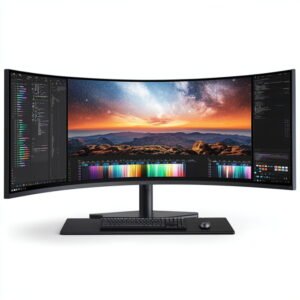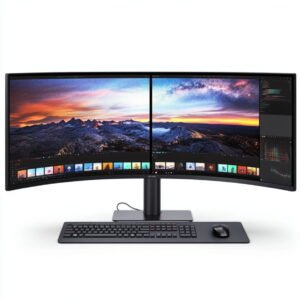Ultrawide monitors are becoming more common, and for good reason. With all that horizontal space, they let you open more windows, multitask with ease, or enjoy games and videos in a cinematic format. But what if you want to take it a step further and split that big screen into two? That’s not just possible — it’s surprisingly easy.
If you’re someone who works with multiple apps or windows at once, turning one ultrawide monitor into two separate working areas can be a game-changer. It feels like having two monitors, but without the clutter of a second screen or extra cables.
What Does “Using an Ultrawide Monitor as Two Monitors” Actually Mean?
When we say you’re using an ultrawide monitor “as two monitors,” we’re not talking about physically changing the hardware. The screen stays the same — you’re just setting it up to behave like two independent displays. That means you can put one app on the left side, and another on the right, and treat them like two separate workspaces.

For example, you might have a browser open on one side and a spreadsheet on the other. Or you might be editing a video while watching a preview next to it. It’s all about making better use of what you already have.
Why It’s Useful
The main benefit is efficiency. Instead of switching between tabs or dragging windows around, everything stays in view. And once you set it up, it just works. Many people say after trying this setup, they never want to go back to juggling windows on a standard monitor.
One user put it simply:
“I split my 34-inch ultrawide into two windows, and now I can run Photoshop and my browser side-by-side without touching the mouse. It’s like night and day.”
Method 1: Using Built-In Features (Windows or macOS)
You don’t need fancy software or extra gear. Most computers today — both Windows and Mac — already include tools to split your screen.

On Windows:
Windows 10 and 11 come with a feature called Snap Assist.
Here’s how to use it:
- Open the window you want on the left side.
- Click and drag the title bar to the far left of the screen.
- Release it when you see an outline appear — it will snap into place.
- Then choose your second app from the suggestions that pop up on the right side.
You can also press Windows Key + Left Arrow or Windows Key + Right Arrow to do it even faster.
This method works well on ultrawide monitors, especially those with 21:9 or 32:9 aspect ratios, where there’s more horizontal space to work with.
On macOS:
If you’re using a Mac, Apple has a similar feature called Split View.
To activate it:
- Hover over the green button in the top-left corner of any app window.
- Select “Tile Window to Left of Screen” or “Tile Window to Right of Screen.”
- Then pick your second app from the other side.
It’s smooth and works well for most tasks. However, macOS doesn’t let you do more than two windows this way — unlike Windows, which allows snapping into thirds or quarters.
Method 2: Picture-by-Picture Mode (PbP) on the Monitor
Some ultrawide monitors come with a built-in feature called Picture-by-Picture, or PbP for short. This lets you take inputs from two different devices — like a laptop and a desktop PC — and show them side by side on one screen.
It’s almost like you’ve physically sliced your monitor into two, giving each half to a different machine.
How to Use It:
- Connect both devices to your ultrawide monitor using separate cables (usually HDMI and DisplayPort).
- Open your monitor’s on-screen display (OSD) menu using the physical buttons.
- Look for a setting called “Picture-by-Picture” or “PbP.”
- Enable it and choose which input goes on which side.
That’s it. Now you’ll see, for example, your work laptop on the left and your gaming PC on the right — both live at the same time.
A quick tip:
“If your monitor supports it, PbP is amazing for managing two systems. I keep my coding setup on the left and a Zoom call running from my Mac on the right.”
Just remember: because both devices are using only half of the screen, the resolution is also split. So text might appear smaller or less sharp than full-screen use. But for many people, the trade-off is worth it.
Method 3: Using Free Software Tools (Like PowerToys or DisplayFusion)
If you want even more control over how your screen is split — maybe you want three sections, or custom window sizes — software can help.
Windows Users: Try Microsoft PowerToys
PowerToys includes a tool called FancyZones. It lets you create custom zones on your screen and snap windows into them.
Here’s how it works:
- Download and install PowerToys from Microsoft’s GitHub page.
- Open the FancyZones tool.
- Choose a layout (two columns, three rows, etc.) or create your own.
- Now when you hold
Shiftand drag a window, it snaps into your chosen zone.
You can even save profiles for work, gaming, editing — whatever suits your workflow.
“FancyZones turned my 38-inch monitor into a true multitasking beast. I have a browser, email, and code editor open at once — no overlap.”
Mac Users: Try Rectangle or Magnet
macOS doesn’t offer as much flexibility as Windows, but third-party apps like Rectangle (free) or Magnet (paid) give you similar snap-to-grid functionality.
They let you use keyboard shortcuts to position windows on the left, right, top, or custom zones.
Final Thoughts: Is It Worth Splitting Your Ultrawide Monitor?
Absolutely — especially if you’re someone who juggles multiple tasks.
Whether you use built-in features like Snap Assist and Split View, take advantage of PbP for two devices, or go all in with FancyZones and other tools, an ultrawide monitor can easily become two monitors in one.
You don’t need more hardware. Just a few smart settings — and a bit of habit change — to unlock a setup that works better, looks cleaner, and helps you stay more focused.
“I bought my ultrawide for gaming. But once I learned how to split it, it became my favorite tool for working, too.”
If you haven’t tried it yet, now’s a good time. You already have the screen — you might as well get double the value from it.